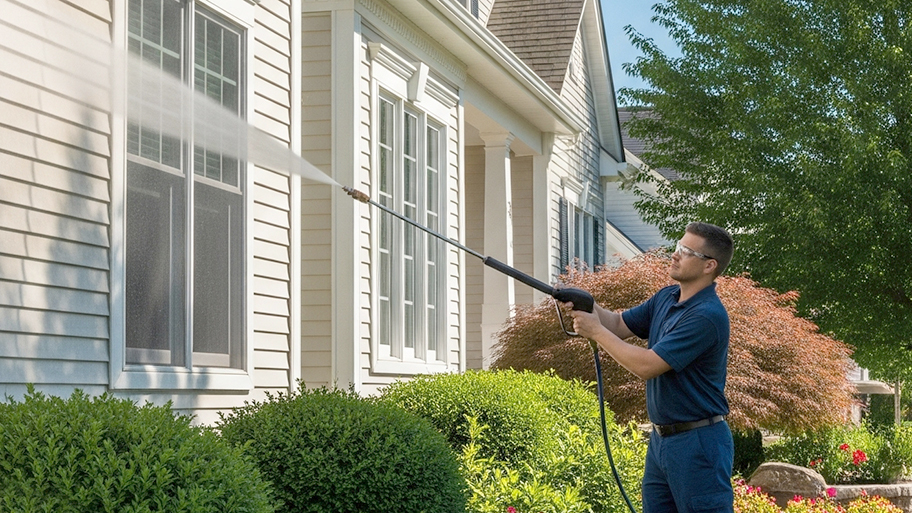
Pressure washing your fence can restore its appearance and keep your home looking great. Learn how much it costs based on factors like square footage and material.
Take the guesswork out of which areas of your home are safe to pressure wash


It’s safe to pressure wash unstained decking; vinyl, aluminum, and cement siding; concrete slabs; outdoor children’s toys and furniture; and garbage cans.
Refrain from pressure washing composite or stained decking; stucco, painted, or brick siding; light fixtures; HVAC units; electric panels; cars; gutters; and aluminum.
If you go the DIY route, wear safety googles, gloves, and long sleeves, use loose tarps to protect nearby areas, and wash from top to bottom.
Hiring a pressure washing pro can cost an average of $300 for a 1,500-square-foot home.
Over time, the exterior of your home can become covered in built-up dirt, debris, and grime. While some of that buildup (like dirty or discolored concrete patios) can be unsightly, some of it (such as mold and algae) can actually damage your home if it’s not properly removed.
Homeowners can tackle these messes with ease by hiring a pro or using a pressure washer themselves. Pressure washing works by turning water from your hose into a targeted cleaning stream you control using a hand-held wand attachment. While wielding one of these wands may make you feel like a cleaning wizard, you’ll need to be mindful of where you’re spraying—not all parts of your home can withstand the intense power of pressure washing.

There are few things as satisfying for homeowners as a DIY project that can be done quickly while creating a big impact, and pressure washing definitely fits that bill. A pressure washer can remove years of built-up grime in a matter of seconds, which is exactly why it’s so important to make sure you’re only using it on surfaces that are safe for this type of cleaning. Otherwise, you can do irrevocable damage before you’ve even realized it.
Unstained decking made from natural wood
Vinyl, aluminum, and cement siding
Concrete slab (including walkways, patios, and driveways)
Children’s outdoor toys
Outdoor furniture and cushions (as long as it’s made of composite wood or plastic)
Garbage cans
Of course, some items aren’t so clear-cut. For example, you can pressure wash clapboard siding, but only if it’s newer than 1978 (if it was manufactured or installed before then, pressure washing may release harmful or toxic materials like lead into the air).
Additionally, you actually can pressure wash gutters as long as your machine has an attachment that allows you to direct the water into them from overhead, and if you can reach them without using a ladder.
A note on safety: It’s never recommended to use a pressure washer while standing on a ladder—doing so may cause a dangerous recoil that could lead to serious injury.
Any list of places that are unsafe to pressure wash around your home will be incomplete because there are just too many variables to make a definitive list. It’s best to avoid power washing any surface that’s close to an electric source (yes, this even includes areas that are otherwise okay to clean this way).
Additionally, turning that magic cleaning wand on your vinyl siding can turn into a big no-no if there are nearby plants that can easily be damaged by the water stream.
Decking made from composite materials or that has been painted with stain
Stucco, painted, or brick siding
Automobiles
Lighting fixtures
Electrical panels or meters
HVAC units
Gutters
Aluminum
Plants and trees
"Most aluminum on a home, like the siding and gutters, is painted," says Leslie Rogers Jr., Angi Expert Review Board member and owner of Clear Pane Windows Plus in Deland, FL. "If pressure is applied, the paint will come off and show the raw aluminum."
After determining which items you can safely pressure wash, it’s important you have a basic understanding of how a pressure washer works. Even if an item can be pressure washed, failure to use machinery correctly can still permanently damage it (or put your safety at risk).
Here are the basics to keep in mind:
Wear safety goggles, ear protection, gloves, boots, and long sleeves
Protect surrounding areas with loose tarps
Select the right target distance and angle
Wash from top to bottom (if cleaning a vertical space)
If you’re unsure of whether an area of your home is safe to clean, you can always opt to err on the side of caution and call in a pressure washing professional. They will be able to determine if power washing is the best option, if you should instead use a method called “soft washing,” or if you need to outsource the job to an expert. A professional power washing job costs nearly $300 on average for a 1,500-square-foot home.
From average costs to expert advice, get all the answers you need to get your job done.

Pressure washing your fence can restore its appearance and keep your home looking great. Learn how much it costs based on factors like square footage and material.

The cost to pressure wash a deck depends on its size, condition, material, and whether you DIY the job. Help set your budget with this cost guide.

Need to breathe new life into your dirty siding and trim? Explore the cost to pressure wash a house to boost your curb appeal instantly.

So you want to hire someone to power wash your deck but don’t know who to call? We’ll help you find the right pro for the job.

The amount of pressure can be the difference between a clean or streaky pressure washing job. What is a good psi for a pressure washer? Find out in this guide.

Cleaning epoxy off concrete via power washer could restore your floors or prepare them for a new look. Learn how to do the job safely with this guide.